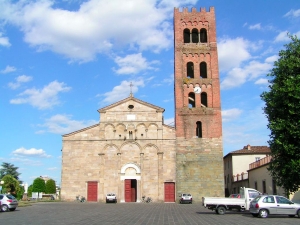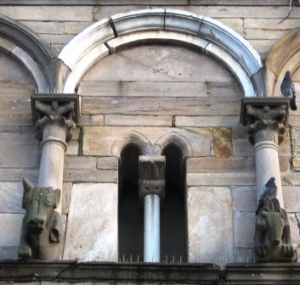
Information
Foundation:
VIII secolo
District/Location:
Capannori
District:
Piana di Lucca


The parish church of Capannori, today dedicated to the saints Quirico and Giulitta, was originally called Saint Quirico a Quarto alla Rotta and is mentioned since the end of the 8th century. Repeatedly rebuilt after that era, it still retains ample passages from its medieval phases.
San Quirico e Giulitta, Capannori
The first document that mentions the church of Santi Quirico e Giulitta dates back to 786, but that church was destroyed in the middle of the 10th century and completely rebuilt in 970. There are no traces of this phase of the building, which was rebuilt again in the 12th century century with a single nave with a double-order façade of blind arches still visible today. It is evident in this last one the reference to the coeval Pisan architecture and to its recordable derivations in various territories facing the Tyrrhenian Sea basin, Sardinia in the first place. Moreover, in the lower part of the same façade there is an important reference to the church of Sant'Alessandro, a reference monument for that phase of Lucca's medieval architecture still independent of the Pisan outcomes: in fact the warm sandstone that constitutes the facing is placed in the San Quirico in rows of alternating heights, thus constituting an example of the so-called pseudoisodom masonry which characterizes precisely the Sant'Alessandro and the churches derived from it. Even the slab with the headless bishop in the counter-façade is affected by this cultural climate, while the capitals decorated in the second order of the façade are from a later period and quite similar to the production of Biduino, a sculptor active in the second half of the 12th century. In these years the church depended on the parish church of San Frediano di Lunata, as shown by the Rationes Decimarum of 1260. The building was then heavily damaged by a fire in the 14th century, but we do not know the changes it underwent on this occasion. A very substantial intervention was instead the one that saw, in 1642, the addition of the side aisles, which were however integrated into the facade perfectly with the medieval structure. In the 19th century, finally, the transept was added and the apse area modified, as well as the interior, where the vault and apse were decorated by the painter Michele Marcucci in 1897, author of the canvas with the Sacred Heart in the left arm of the transept and the one with Anime del Purgatorio in the second altar on the right. In 1448 the Borghese painter of Pietro Borghese - who for this reason has long been known only as the Master of Saints Quirico and Giulitta - painted the polyptych with Saints Quirico and Giulitta, some compartments of which are preserved in London at the Courtauld Institute .
Scopri altre attrazioni vicino a Saints Quirico and Giulitta
See allYou may also like..
See allFind more
0













